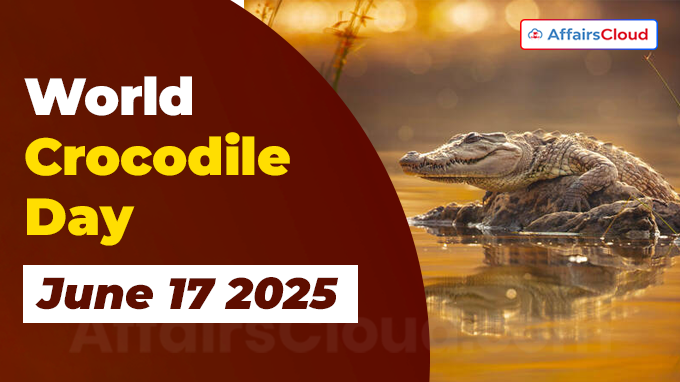 World Crocodile Day (World Croc Day) is annually observed across the globe on June 17 to raise awareness about the conservation challenges facing endangered crocodiles and alligators, and to promote the importance of protecting these species.
World Crocodile Day (World Croc Day) is annually observed across the globe on June 17 to raise awareness about the conservation challenges facing endangered crocodiles and alligators, and to promote the importance of protecting these species.
- In 2025, the observance is led by the Belize (Central America)-based nonprofit organisation, Crocodile Research Coalition (CRC), in collaboration with the Belize Zoo.
- The theme for World Crocodile Day 2025 is “Connecting crocodiles and communities.”
Background:
i.World Crocodile Day was established in 2017 by the Crocodile Research Coalition (CRC).
ii.The initiative was launched under the leadership of Dr. Marisa Tellez to promote global awareness about crocodilian species and the urgent need for their conservation.
About Crocodiles:
i.Crocodiles(Scientific name – Crocodylidae) are cold-blooded, semi-aquatic reptiles found in tropical regions of Africa, Asia, the Americas, and Australia.
ii.They belong to the order Crocodilia, which comprises 26 recognised species, many of which are listed as Vulnerable or Critically ‘Endangered’ by the International Union for Conservation of Nature (IUCN).
Difference between Crocodiles and Alligators:
i.Snout shape: Crocodile snouts are long and V-shaped; alligator snouts are wide and U-shaped.
ii.Habitat preference: Crocodiles prefer saltwater, while alligators are found mainly in freshwater environments.
Significance and Threats:
Crocodilian populations are declining globally due to multiple threats, including:
- Habitat destruction due to agriculture, dredging, pollution, and urbanisation.
- Illegal poaching for their skin and meat.
- Human–wildlife conflict, especially near riverine and coastal areas.
- Climate change impacts nesting patterns and sex ratios of hatchlings.
Crocodile Species in India:
India hosts three distinct species of crocodiles.
i.Mugger crocodile (Crocodylus palustris): Vulnerable (IUCN status).
ii.Saltwater crocodile (Crocodylus porosus): Least Concern .
iii.Gharial (Gavialis gangeticus): Critically Endangered.
Crocodile Conservation Project in India:
i.The Crocodile Conservation Project was launched in 1975 by the Government of India (GoI) with support from the New York, United States of America (USA) based United Nations Development Programme (UNDP) and the Rome (Italy) based Food and Agriculture Organization (FAO).
- The project marked its 50th anniversary on 17 June 2024, coinciding with the observance of World Crocodile Day 2024.
ii.The project aims to protect these reptiles in their habitats, curb hunting, and boost populations via captive breeding.
iii.It was first implemented in Odisha, with a primary focus on conserving the saltwater crocodile in Bhitarkanika National Park, Odisha.
iv.In 1980, the Crocodile Breeding and Management Training Institute was established in Hyderabad, Telangana, to support research, training, and breeding initiatives.
Note: India currently hosts 80% of the world’s wild gharials, with a total gharial population of around 3,000, and approximately 2,500 saltwater crocodiles nationwide.
Odisha Marks 50 Years of Crocodile Conservation:
On 17 June 2025, Odisha (India) celebrated the 50th anniversary of its pioneering crocodile conservation programme. Initiated in 1975, this program established Odisha as India’s only state hosting wild populations of all three native crocodilian species: Saltwater Crocodiles, Gharials, and Muggers.
Population Recovery (India) of Crocodile 2025 Data:
i.1,826 Saltwater Crocodiles in Bhitarkanika National Park in Paramanandpur(Odisha).
- The 2025 census recorded a slight increase from 1,811 in 2024. The survey, conducted from January 19 to 21,2025 included 585 hatchlings, 403 yearlings, 328 juveniles, 164 sub-adults, and 346 adults.
ii.16 Gharials in Satkosia Gorge Sanctuary, Tikarapada(Odisha).
iii.Around 300 Muggers across state waterways



